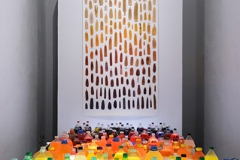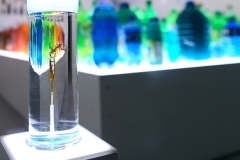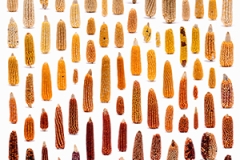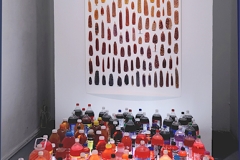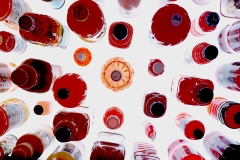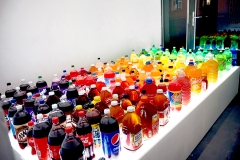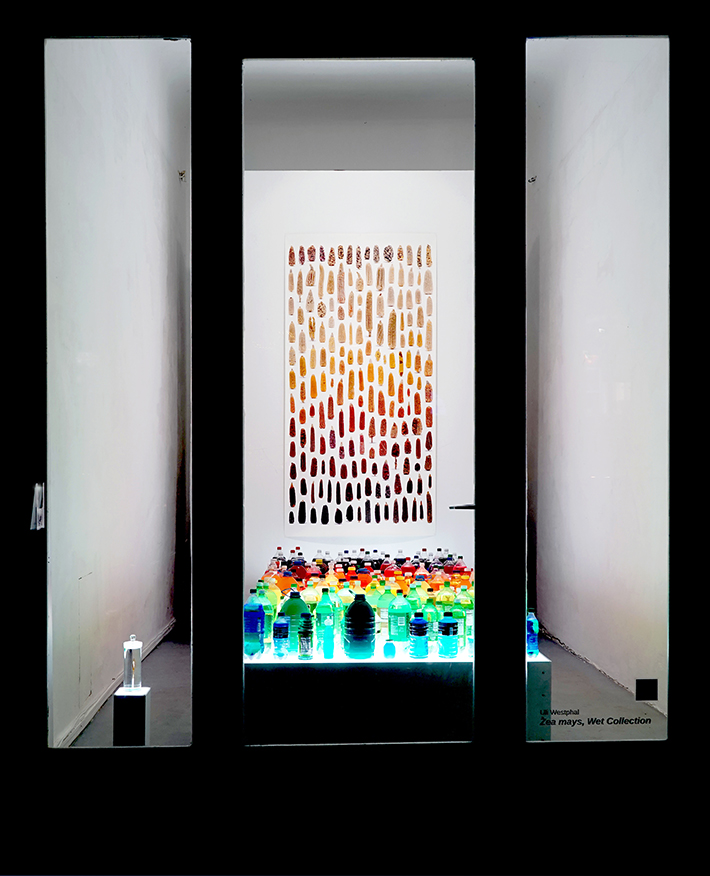
Zea mays, Wet Collection – eine Installation von Uli Westphal
Corn cultivars from all parts of the world. Photographed 2018 at the CIMMYT seed bank in Texcoco, Mexico. Bottles containing drinks from High Fructose Corn Syrup based soda (collected 2018 in Providence, RI, USA).Teosinte in Bio-Ethanol
Uli Westphal dokumentiert die schwindende Nutzpflanzenvielfalt und das, was an ihre Stelle tritt. Die Installation verbindet Fotografien und gefundene Objekte zu einer leuchtenden Rauminstallation, die die Transformation vom Mais nachzeichnet.
Vor 10.000 Jahren führte eine Reihe von zufälligen Mutationen dazu, dass aus einem unscheinbaren Gras, der Teosinte, der Vorfahre des Mais wurde. Jahrtausendelange Selektion durch den Menschen hat zu dramatischen Veränderungen beim Mais geführt. Menschen entwickelten eine Vielzahl von Sorten mit unterschiedlicher Form, Farbe, Geschmack und kulinarischer Verwendung, die jeweils an die Kultur, die Geografie und das Klima der Orte angepasst waren, an denen sie angebaut wurden. Heute wird im Maisgürtel der USA, einem Gebiet von der Größe Kaliforniens, fast ausschließlich eine einzige Maissorte namens Yellow Dent angebaut. Fast das gesamte Saatgut ist gentechnisch verändert und geistiges Eigentum, das von den wenigen agrochemischen Konzernen kontrolliert wird, die den globalen Saatgutmarkt beherrschen. Der größte Teil der Ernte wird zu Ethanol oder zu Tierfutter verarbeitet, um in Massentierhaltung billiges Fleisch zu erzeugen. Nur ein Bruchteil der Ernte wird für den menschlichen Verzehr verwendet, vor allem in Form von Süßungsmitteln, insbesondere von High Fructose Corn Syrup.
english
Uli Westphal documents disappearing crop diversity and the things replacing it. Zea mays, Wet Collection combines photographs and found objects into a glowing spatial installation that traces the transformation of corn.
10,000 years ago a series of chance mutations caused an inconspicuous weed, Teosinte, to become the ancestor of corn. Millennia of selection by humans have yielded dramatic changes to corn. Farmers developed a multitude of cultivars of varying shape, color, flavor and culinary use, each adapted to the culture, geography and climate of the places they were grown. Today, the US Corn Belt, an area roughly the size of California, almost exclusively grows a single type of corn called yellow dent. Nearly all of the seed is genetically modified and intellectual property, controlled by the few agrochemical corporations that rule the global seed market. Most of the harvest is turned into ethanol or animal feed to produce cheap meat in concentrated feeding operations. Just a fraction of the harvest is directed towards human consumption, primarily in the form of sweeteners, particularly High Fructose.

